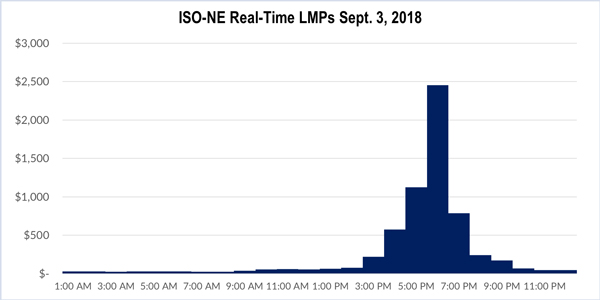By Michael Kuser
Hot and humid weather some 5 degrees higher than forecast and 1,600 MW of unplanned generator outages sent ISO-NE power prices soaring last Monday and led the RTO to purchase emergency energy from New York and Canada.
Temperatures hit 96 degrees Fahrenheit in Boston on Sept. 3 with a dew point of 73 as load peaked at 22,956 MW, almost 2,400 MW above the initial forecast of 20,590 MW. The bulk power system saw a five-minute peak of 23,106 MW at 5:50 p.m., according to a Sept. 7 article published on the RTO’s website.
Real-time energy prices rose to $2,454.57/MWh between 4 and 5 p.m., and reserve prices peaked at about $2,500/MWh at times between 3 and 6 p.m.
Similar weather conditions, with a heat index at or near 100, were forecast for the following Tuesday. Load peaked at about 23,000 MW, in line with forecasts, and no alerts were issued. Boston peaked at 85 degrees.
When the dew point is above 70, every 1-degree increase can cause load to rise by about 500 MW, with rising temperatures causing similar effects on load.
The RTO implemented Master/Local Control Center Procedure No. 2 (M/LCC 2) at 3:15 p.m. Monday, declaring an Abnormal Conditions Alert and directing generators and transmission owners to stop or postpone any maintenance activities that could jeopardize system reliability.
Fifteen minutes later, the RTO implemented Operating Procedure 4, Actions 1 and 2. Action 1 declares a Power Caution, saying available capacity resources are insufficient to meet anticipated demand plus operating reserve requirements. Action 1 also allows the RTO to begin depletion of 30-minute operating reserves. Action 2 declares a Level 1 energy emergency alert.
At 4 p.m., system operators issued a Power Watch and implemented two other actions of OP4, asking market participants to reduce energy consumption at their own facilities and arranging for purchase of emergency capacity and energy from neighboring systems.
All of the alerts were lifted by 9 p.m.
ISO-NE spokeswoman Marcia Blomberg told RTO Insider that the Labor Day heat resulted in “higher-than-expected demand, as well as some generator outages” and that the RTO purchased emergency power from New Brunswick and New York for a short time. “While we implemented Action 4 of OP4, declaring a Power Watch, we didn’t issue a request for voluntary conservation. We were monitoring the system and could have issued an appeal if conditions had deteriorated.
Emergency purchases from NYISO totaled 251 MW from 5 to 5:30 p.m. and 100 MW in the following half-hour, while emergency purchases from New Brunswick totaled 150 MW from 4:20 to 5:14 p.m. and 229 MW from then until 6 p.m.
“However, conditions improved rapidly as demand began to decline in the late afternoon and offline generators were able to come online quickly,” Blomberg added.
ISO-NE’s operations shift supervisor or one of its six local control center system operators can declare an abnormal condition under several scenarios, including a forecasted or actual deficiency of operating reserves. The local control centers, which are run by transmission owners, are generally responsible for transmission facilities rated 69 kV and below.
The RTO reported “underperforming resources will be penalized at a rate of $2,000/MWh for failing to meet their obligation during energy shortfalls, while resources that overperform (including resources with no obligation) will receive $2,000/MWh of additional revenue.”
The performance payment rate will increase to $5,455/MWh over the next six years.



